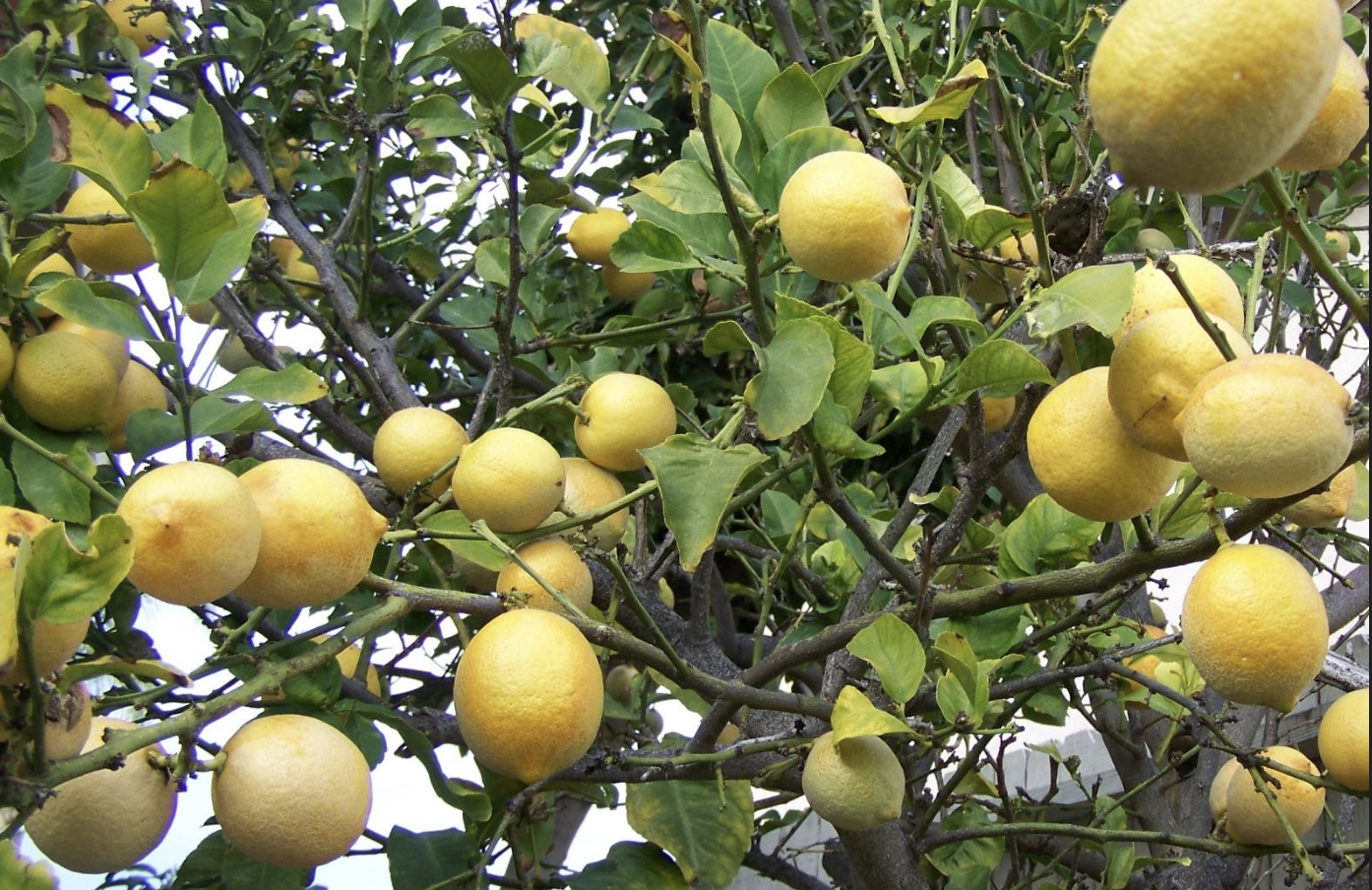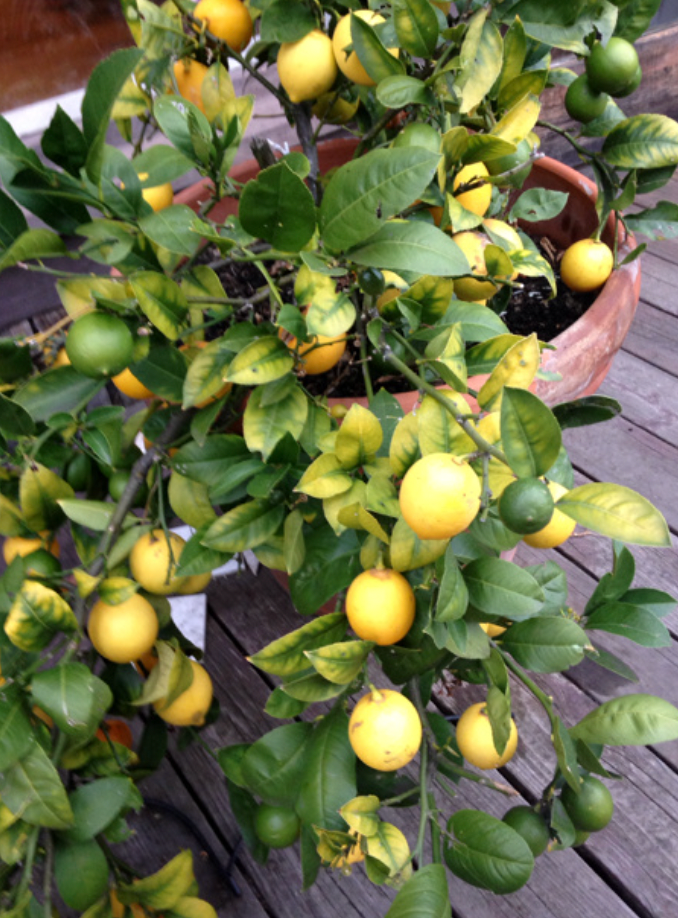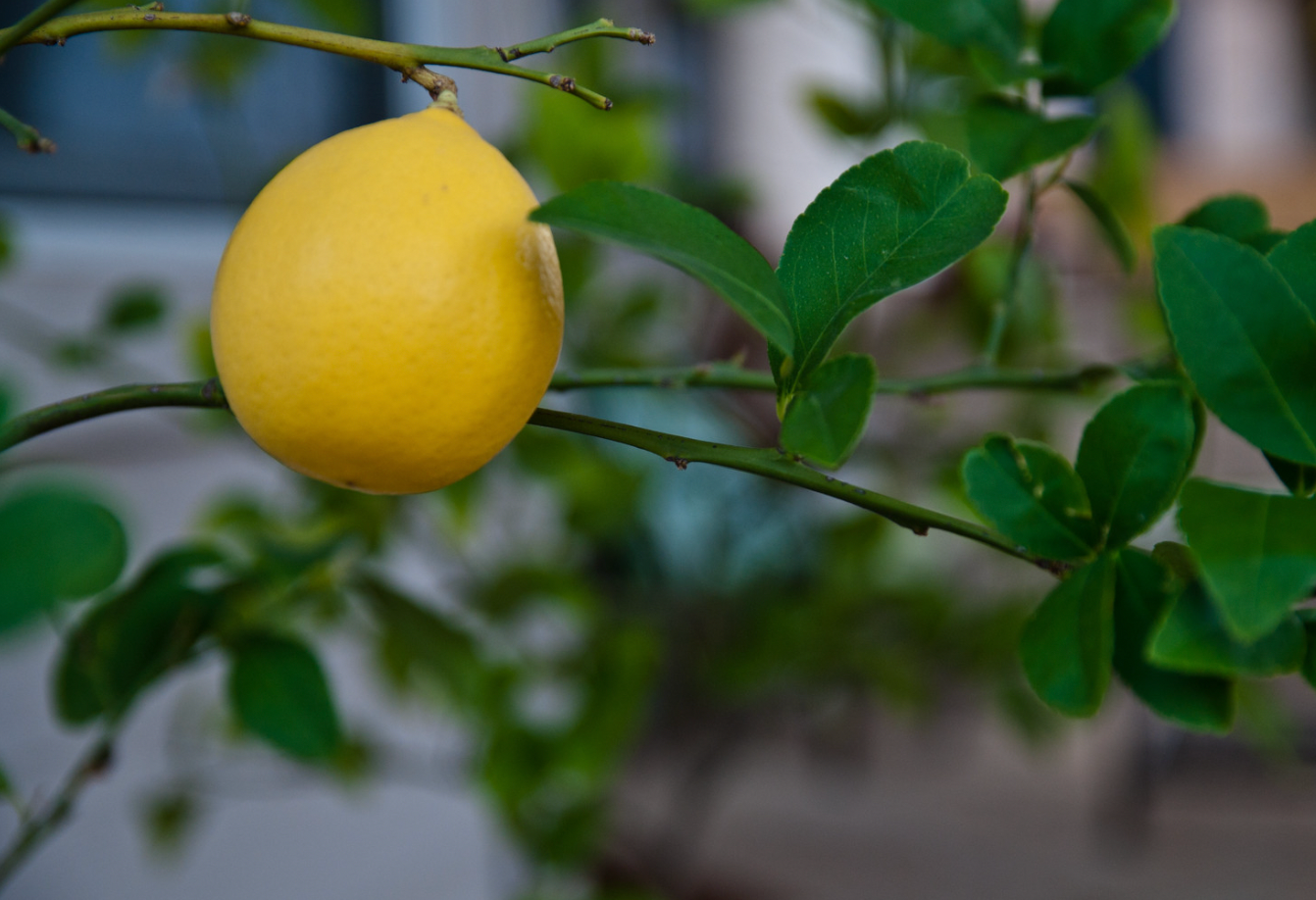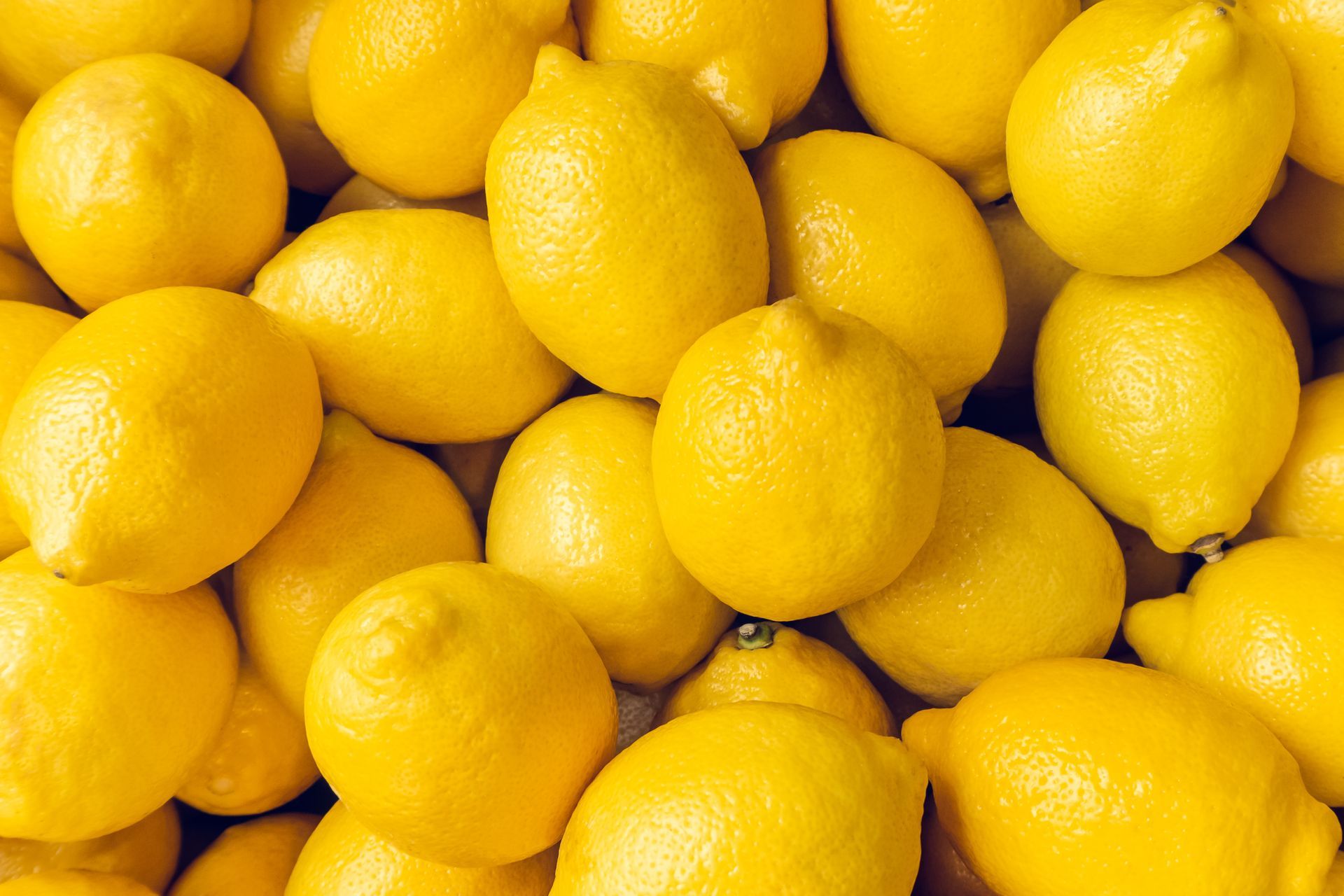Meyer Lemon Tree Care

Meyer Lemon Tree Care isn't complicated. That, and the delicious lemons this tree produces make the Meyer Lemon tree a favorite. It is one of the most popular trees to grow in the United States.
Fast Facts for Meyer Lemon Tree Care
| Common Name | Perfect Lemon Tree, Improved Meyer Lemon Tree, Dwarf Mayer Lemon Tree |
|---|---|
| Scientific Name | Citrus x meyeri “Improved” |
| Harvest Months | 4 to 8 months |
| Light | Full sun. 8 - 10 hours of direct sunlight per day. |
| Water | Water deeply when top 3 inches of soil dried out |
| Soil | Well-drained, loamy |
| Fertilizer | Fertilize once a month from spring to fall months, if the plant has yellow leaves, you made need more (read below) |
| Pests | Aphids, whiteflies, scales, mites |
| Diseases | Citrus canker, root rot, fungus |
| Growing Zone | 4 to 11 patio; 8 to 11 outdoors (hardy down to 20F) |
Table of Contents
Meyer Lemon Tree Care

Credit: Scott Nelson
To ensure your
Meyer Lemon tree grows to be productive and fruit-bearing, follow these simple tips.
Soil & Container
Citrus fruits do not want 'wet feet,' so they don't want the soil to be overly moist. Drainage holes are ideal, but if you put the tree into a container without them, just be very careful about watering it.
After a while of growing, it might be best to just switch to a container with drainage holes as too much water in the pot can be really detrimental to citrus trees. Keep the soil moist but not soaking wet. To keep the soil moist but not too wet, you are going to be watering once a week or biweekly.
Sounds weird, but the cactus and succulent mix for potting soil can be a good choice for citrus. If you go with a container, the container must be deeper than it is wide. It's a tree, so the root system needs plenty of room to grow.
Root Inspection
When transplanting the tree, be sure to inspect the root system. You don't want any circling roots. Lightly loosen up the roots, and tease it open. You want the root ball's soil to be about an inch lower than the top of the container so you can fill in the remaining soil.
Fertilizing and Filling
Light fertilization with bone meal, broth meal, chicken manure, etc. If that sounds complicated, just fertilize with a high-nitrogen blend between April and September. Buy fertilizer that is geared towards citrus trees. The one we like is here.
Sun & Placement
When you are growing in a container, you can grow indoors. You must put it right against a south-facing window if you grow it indoors. But wants 8 - 10 hours of direct, full sunlight. That can be pretty difficult to accomplish indoors without any sort of grow light so keep that in mind.
Pruning
Get out your best loppers and begin to manicure and sculpt the shape of the Meyer lemon tree. Remove non-fruiting branches that are growing straight up. Remove any branches that cross the tree, or grow inwards in general. You don't want pockets of humidity that can harbor disease and other pests that can hurt the tree.
To avoid letting the Meyer Lemon grow more shrubby-style, remove all growth that starts to shoot out from the lower down on the truck. If you wanted, Meyer Lemons are a popular tree to espalier.
You can prune each fruit cluster so that it has only one or two fruits. Doing this allows the plant to put more energy into limited fruits which actually makes them healthier and tasted even better.
Meyer Lemon Tree Problems

Credit: Mark Bonica
No tree comes without some potential issues you need to look out for. The Meyer Lemon Tree is no different. If the Meyer Lemon Tree has:
- No Flowers
- Yellow Leaves
- Wilting or Drooping Leaves
- Damaged Leaves
You will need to alleviate the issue. For Meyer Lemon trees, that can take some troubleshooting. Most of the issues surrounding how you water the tree, so determine what symptom the tree has and adjust from there.
Not Flowering
If you aren't getting too much fruit, that is probably a result of lack of sunlight. If you are growing indoors, getting the proper sunlight without a growing light will be hard. Make sure the tree is near a south-facing window, and gets 8 to 10 hours of direct sunlight per day.
Yellowing Leaves
Yellowing leaves on Meyer Lemon trees can be signs of overwatering, under-watering, or not enough nitrogen. You will have to troubleshoot and experiment to determine the reason. Yellowing leaves could be a sign that you need more fertilizer.
Wilting Leaves
Overwatering issue. Leaves will start to sag. Soil test - stick your finger down a couple inches, and make sure it's dry. Don't water unless you have about 3 inches of dry soil on the top.
You may also want to check for root rot. Too much watering can lead to a common fungal infection among citrus trees known as Armillaria root rot.
Damaged Leaves
Damaged leaves are almost always due to pests. If the bottom of your Meyer Lemon Tree leaves have damage, you may have white flies, aphids, or even scale.

Learning About Meyer Lemon Trees
Meyer Lemons are unique lemons because they are a cross between a traditional sour lemon and a sweet orange. Unlike the acidic lemons of your grocery store, Meyer Lemons give you both a sweet and savory flavor with just a squeeze.
It's sought after by chefs and cooking enthusiasts alike because of its uniquely delicious taste. It has that sweet, homegrown taste.
Meyer Lemon trees make for some of the best indoor trees. If you can get them next to a bright window for partial to full sun, they'll be fine. They can:
- Thrive indoors and outdoors
- Fruit in three years or less
- Tolerate both cold and heat remarkably well
As mentioned above, you won't find Meyer Lemons in typical grocery stores. They aren't bred for shelf life. They are bred for taste. Whereas a normal lemon can survive long, bumpy transports and shelf time, the Meyer Lemon would easily bruise and suffer.
Improved Meyer Lemon Tree
The improved Meyer Lemon Tree grows twice as fast, can produce fruit as soon as the first year, and is resistant to insects and diseases, so they don't need harsh chemicals.
Meyer Lemon Tree Origin Story
Meyer Lemons were originally imported to the US from China. The tree is supposedly a cross between a mandarin orange and a lemon. Crazy. Meyer Lemon trees sold in nurseries will be grafted to a rootstock, taking around two years to bear fruit.
When they were imported, they also imported a hostile citrus virus. It wasn't until the University of California bred a new and "improved" lemon tree that we have the lemons we do today. These improved varieties were much more resistant to the lethal citrus virus.
In fact, since the 1970s, the only variety that has been around is the Improved one. They can grow up to 8 to 12 ft. but, depending on how you raise them, can also be grown like shrubs. If you plant them in a container, they won't grow much higher than 4 feet tall.
Where Can You Buy A Meyer Lemon Tree?
We get all our trees from here. If you want to taste the sweet Lemon fruit, you must find a restaurant that uses them or grow the tree yourself. Meyer Lemons are not commonly sold in grocery stores.
Sweet New Earth's Final Word On Meyer Lemon Tree Care
Anything that is a cross between a mandarin orange and a lemon tree is destined for greatness. The Meyer Lemon tree is simply that: great—one of the best indoor trees and one of the best outdoor trees. Arguably one of the best citrus trees. Could even be one of the best front yard trees (depending on your yard). But everybody loves a good lemon, and Meyer Lemon trees make the best.
FAQs

Christina Hernandez
Christina has done most of her research on environmental science but recently has changed her focus towards sustainable forestry. She has a passion for the outdoors and wants to spread that passion to the world.
Join our community!
Join to receive guides, insights, and the latest gardening deals!
